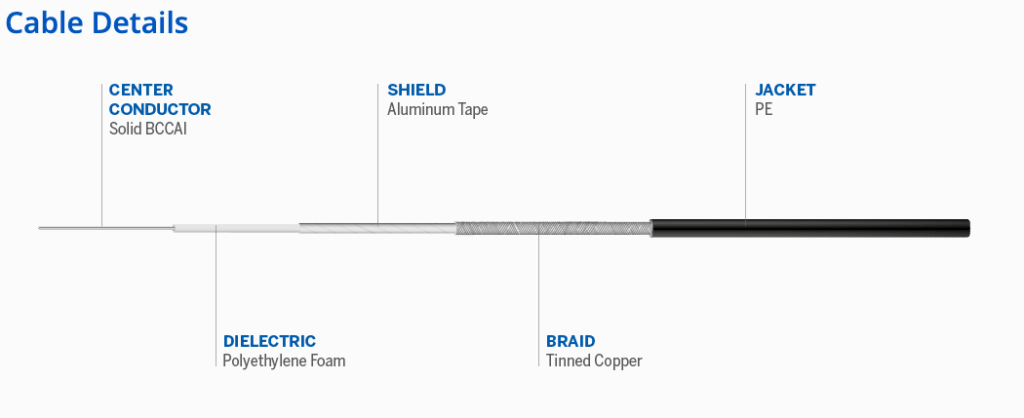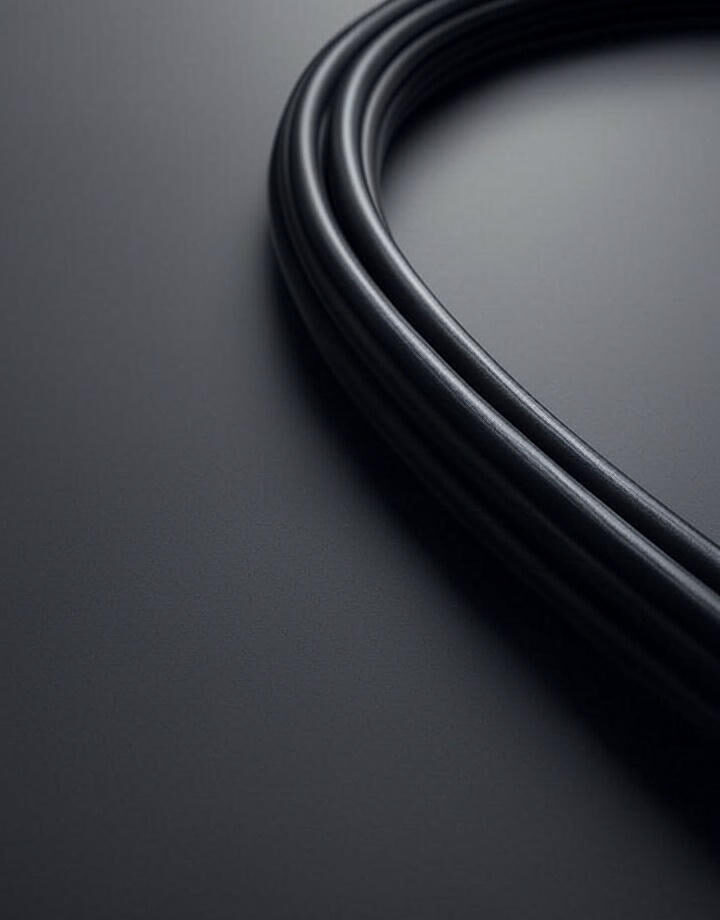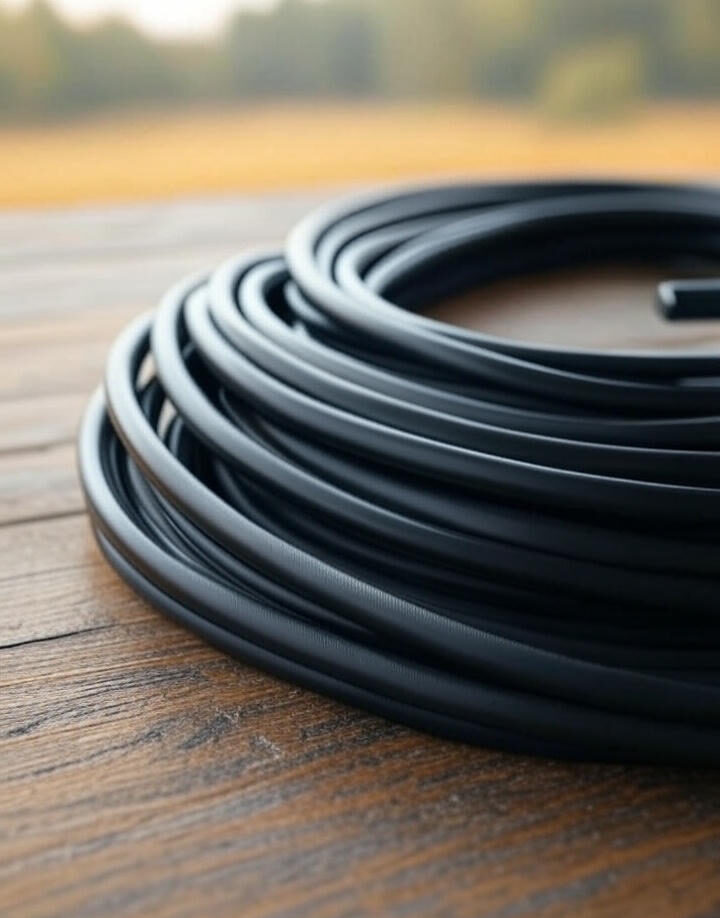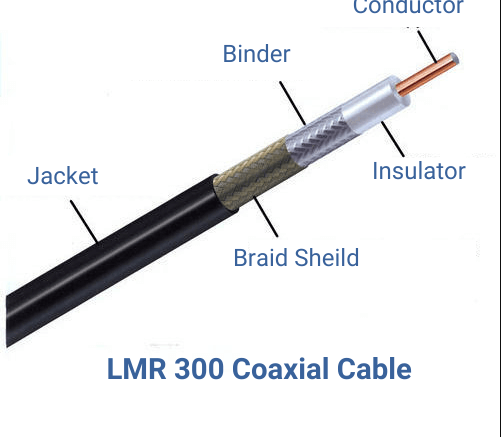LMR 300 Coaxial Cable: The High-Performance RF Transmission Solution
In the world of RF and wireless communications, LMR 300 coaxial cable has established itself as a premium choice for professionals requiring low-loss, high-frequency signal transmission. As a leading coaxial cable manufacturer, we specialize in producing top-grade LMR 300 cables that deliver exceptional performance in demanding applications.
This comprehensive guide will explore the features, benefits, technical specifications, and applications of LMR 300 cable. We’ll also compare it with its close variant, HLF 300, to help you make an informed decision for your connectivity needs.
What is LMR 300 Coaxial Cable?
LMR-300 is a low-loss 50-ohm coaxial cable developed primarily for RF (Radio Frequency) applications. It strikes a balance between power handling, low signal attenuation, and flexibility—making it an ideal solution for installations that require high-performance signal transmission without the bulk of larger cables like LMR-400. It is commonly used for medium-range RF applications like cellular repeaters, two-way radios, Wi-Fi access points, GPS systems, and more.
This cable is manufactured using a solid bare copper conductor, closed-cell polyethylene dielectric, dual shielding (aluminum foil and tinned copper braid), along with a rugged UV-resistant polyethylene jacket. These attributes make it a robust, outdoor-friendly cable with excellent electrical performance. Its popularity stems from its excellent electrical characteristics paired with superior flexibility compared to older, rigid coaxial cables.
Unlike traditional RG-series cables, LMR 300 offers significantly lower attenuation while maintaining excellent flexibility, reducing the need for bulky jumpers or rigid installations. It’s available in various configurations, such as standard LMR-300, ultra-flexible LMR-300-UF (with a stranded center conductor), and direct-burial LMR-300-DB for underground deployments.
This cable’s construction prioritizes low insertion loss, making it ideal for medium-length runs where signal integrity is paramount without the premium cost of heavier-duty options like LMR-400.
It belongs to the Times Microwave Systems‘ LMR® series and is widely regarded as a superior alternative to traditional RG cables due to its:
Lower signal attenuation
Better shielding effectiveness
Superior flexibility
Weather-resistant construction

The Anatomy of Excellence: How LMR 300 is Constructed
The performance of LMR 300 is a direct result of its precision engineering. Our manufacturing process ensures each layer is optimized for signal integrity and durability:
Center Conductor: A solid bare copper core. This provides excellent conductivity for efficient signal transmission.
Dielectric: A foam polyethylene insulation. This material is key to the cable’s “low-loss” properties. By using a foam structure, we achieve a lower dielectric constant than solid polyethylene, which minimizes signal loss (attenuation) across a wide frequency range.
Shield: A dual-shield design for superior protection against Electromagnetic Interference (EMI).
First Layer: An aluminum foil shield bonded to a polyester film. This provides 100% coverage against high-frequency interference.
Second Layer: A tinned copper braid. This braid offers structural integrity, excellent flexibility, and additional shielding, particularly against lower-frequency interference.
Jacket: A durable, UV-resistant Polyethylene (PE) or PVC jacket. The PE jacket is standard for outdoor use, offering protection from sunlight, moisture, and temperature extremes. A PVC jacket is an option for more flexible, indoor applications.

Benefits and Advantages of Using LMR 300
Low Signal Loss: With attenuation rates much lower than RG-58 or RG-213, LMR 300 ensures maximum signal strength over long distances.
High Shielding Effectiveness: Dual-layer shielding provides excellent EMI/RFI protection, maintaining signal integrity in electrically noisy environments.
UV-Resistant Jacket: Ideal for outdoor installations, the LMR 300 withstands harsh environmental conditions, including UV exposure and moisture.
Flexible and Easy to Install: Despite its robust build, LMR 300 is relatively flexible and can be installed in tight bends or corners without performance degradation.
Wide Frequency Range: Suitable for frequencies up to 6 GHz, making it versatile across various RF and microwave applications.
- Superior Durability and Weather Resistance: The thermoplastic elastomer jacket withstands UV exposure, moisture, and temperatures from -40°F to +185°F, ensuring longevity in outdoor setups. Variants like LMR-300-DB add water-blocking for direct burial.
- Cost-Effectiveness: LMR 300 offers a fantastic performance-to-price ratio, delivering high-end features without a premium cost.
- Broad Compatibility: Works seamlessly with standard connectors (N-type, SMA, TNC) and supports high peak power up to 10 kW, making it versatile for both low- and high-power systems.
- Superior Durability and Weather Resistance: The thermoplastic elastomer jacket withstands UV exposure, moisture, and temperatures from -40°F to +185°F, ensuring longevity in outdoor setups. Variants like LMR-300-DB add water-blocking for direct burial.
These benefits translate to faster installations, lower long-term costs, and reliable performance, which is why LMR 300 remains a bestseller for coaxial cable manufacturers.


Where is LMR 300 Cable Used? Common Applications
LMR 300 is incredibly versatile. Its versatility shines in diverse RF scenarios, particularly where moderate cable lengths (up to 100 feet) demand low loss without excessive rigidity. It is used extensively in both commercial and industrial sectors for RF and wireless connectivity. Some of the major applications include :
- Wireless Infrastructure: Connecting antennas to base stations for cellular (4G/5G), Wi-Fi, and WLL systems, ensuring strong coverage in buildings or remote sites.
- Broadcasting and Video Distribution: Used in CCTV, CATV, and baseband video feeds for low-distortion signal transport over medium distances.
- GPS and Navigation Systems: Linking GPS antennas to receivers in vehicles, marine, or aviation setups, where precise timing is critical.
- Two-Way Radios and Public Safety: Ideal for repeater systems and mobile radios, providing reliable links in emergency communications. Both in UHF and VHF.
- Satellite and Radar Systems: High-power handling supports feeder lines in satellite dishes and radar arrays for defense or aviation.
- In-Building and DAS (Distributed Antenna Systems): Feeder runs for indoor wireless coverage, reducing signal degradation in high-density environments.
Amateur Radio (Ham Radio): A popular choice for radio enthusiasts due to its balance of performance and flexibility.
WiFi Networks: Ideal for linking access points to antennas, especially in large-scale deployments like campuses or warehouses.
HLF 300: The Close Variant to LMR 300
HLF 300 is a popular coaxial cable that closely mirrors LMR 300 in design and purpose, often marketed as an “LMR-type” or equivalent product by third-party manufacturers. Like LMR 300, it’s a 50-ohm, low-loss cable built with a copper alloy inner conductor and foam PE dielectric, optimized for RF transmission up to 6 GHz. HLF 300 is weatherproof, corrosion-resistant, and supports applications in Wi-Fi routers, mobile signal boosters, GPS, and CCTV systems. It’s particularly favored in cost-sensitive markets for its uninterrupted signal transfer and high-temperature resistance.
While not an official Times Microwave product, HLF 300 is engineered to deliver comparable low-loss performance, making it a go-to for budget-conscious projects without sacrificing core functionality.
| Feature | LMR 300 | HLF 300 |
|---|
| Brand | Times Microwave Systems (industry standard) | Generic/Alternative Brands |
| Construction | Solid copper conductor, foil & braided shield | Similar but often with slightly lower shielding quality |
| Attenuation Loss | Very Low | Low to Moderate |
| Shielding Effectiveness | High (90%+) | Varies by manufacturer |
| Durability | Excellent (UV, water, and corrosion resistant) | Depends on build quality |
| Price | Premium pricing | Generally more affordable |
| Certifications | Widely certified for telecom and military-grade use | May lack standard certifications |
Which One Should You Choose?
In summary, LMR 300 edges out in precision engineering and longevity, ideal for mission-critical installs, while HLF 300 provides near-identical performance at a fraction of the cost—perfect for standard residential or small-scale commercial needs. If signal integrity is non-negotiable, opt for LMR 300; for value-driven projects, HLF 300 won’t disappoint.
Choose LMR 300 for most general-purpose, cost-effective applications, especially standard outdoor installations.
Choose HLF 300 when installing cable in enclosed public spaces, transportation systems, or any area where building codes mandate low smoke and zero halogen materials for safety.
As a leading coaxial cable manufacturer, we ensure that our LMR 300 cables meet the highest industry standards. Our in-house quality control, state-of-the-art manufacturing process, and strict adherence to international specifications guarantee reliability, signal integrity, and customer satisfaction.
Whether you’re building a mobile communication setup, installing a surveillance system, or deploying a wireless network infrastructure — our LMR 300 cable delivers powerful performance and peace of mind.
Conclusion: LMR 300 – The Go-To Solution for Robust RF Performance
LMR 300 coaxial cable remains a cornerstone of modern RF systems for a simple reason: it works. Its proven design, combining low attenuation with exceptional flexibility and durability, makes it the default choice for installers and engineers worldwide.
Understanding the subtle but critical difference between standard LMR 300 and the safety-focused HLF 300 variant ensures you not only get great performance but also comply with safety regulations.
As a cornerstone of modern coaxial cable solutions, LMR 300 coaxial cable delivers unmatched reliability for everything from everyday Wi-Fi boosts to sophisticated wireless networks. Its low-loss design, flexibility, and robust build make it the clear choice for applications demanding efficiency and endurance. When weighing options like HLF 300, remember that while equivalents offer great value, the original LMR 300 sets the benchmark for quality.
At our company, a leader in coaxial cable manufacturing, we’re proud to produce high-quality LMR 300 that meets or exceeds industry standards. Ready to integrate LMR 300 into your next project? Contact us today for custom lengths, connectors, and expert advice to optimize your signal chain. For more insights on coaxial innovations, keep exploring our resources!

